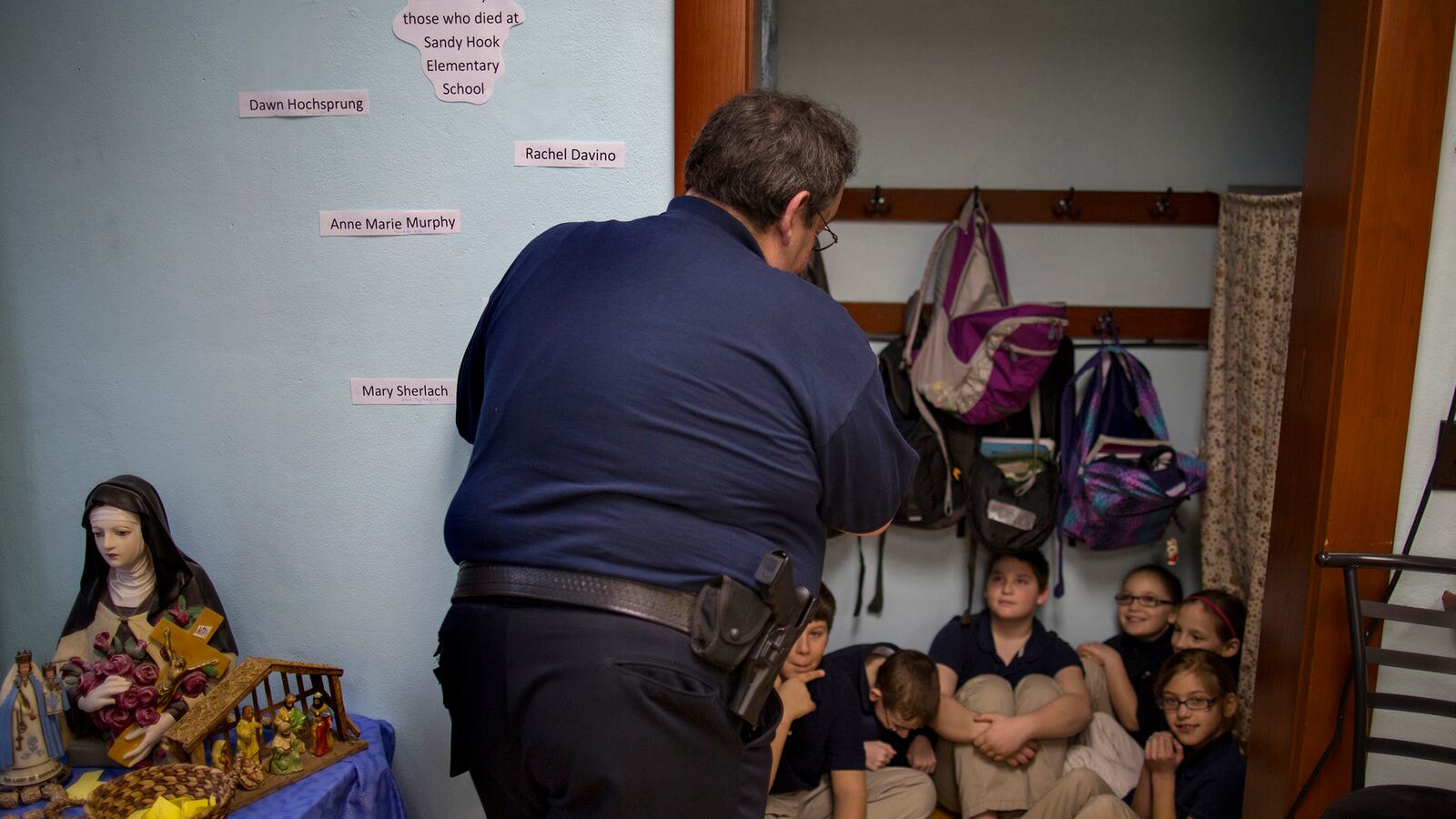Today, Addison High School in Lenawee County, Michigan is holding an emergency preparedness drill involving “a car fire diversion that enables six individuals to launch a shooting spree”. Two victims, played by student volunteers, will be “killed” and eight wounded in the type of full-scale exercise now required by law in several states.

School districts across the country are responding to new state regulations implementing mock shooting scenarios varying in scale and intensity, the more realistic drills involving simulated fatalities and victims played by student volunteers. But as some students and staff begin to report more stress than preparedness, experts worry that if not carried out with proper caution, these exercises could do more harm than good.
Since the tragedy at Newtown, Conn., in which 20-year-old Adam Lanza shot and killed twenty children and six staff members, issues of school safety and gun control have become a central public concern. However, in spite of the inevitable media crush following a mass shooting, these events remain a statistically rare occurrence and school administrations and law enforcement may be going too far in a rush to protect students.
Last month, some 300 students at Cherry Valley, Arkansas’ Cross County High participated in an active shooter training drill. On March 18th, the sheriff’s department alongside police, firemen, dispatchers, paramedics, and evaluators from around the state came together to test the school and local law enforcement’s ability to handle an armed intruder. Carrying a gun filled with blanks, the shooter entered a classroom of twenty students, taking one student hostage. While he had his arm around the student and a gun to his side, police entered and took the shooter out.
In what Superintendent Carolyn Wilson described as a “totally transparent” drill, students, law enforcement, and the community were informed ahead of time of what would be taking place. What the students did not know is that the shooter would be played by someone they were very familiar with, their local pastor and school janitor.
"I felt betrayed," senior D. J. Roberts told his local news station, "I was scared because I saw him coming with the gun and I was like, 'Oh my gosh!'"
Riley Stephens, who acted as the hostage and whose mother played the second shooter describes entering the classroom of students and seeing “some more frightened than others.” “One of my teachers was very upset,” Stephens told The Daily Beast.
Cross County’s drill is certainly not the first to receive attention for the stress caused to its students. Responding to complaints from parents after an unannounced drill at a Cahokia, Illinois elementary school last month, the superintendent said, “I’d much rather your children be a little bit scared and alive, than not knowing what to do and end up being hurt."
In spite of these reports of student anxiety, state lawmakers continue to pass new regulations requiring intruder drills. Illinois, Missouri, New Jersey, Oklahoma, and Tennessee join Arkansas in requiring schools to stage these type of full-scale exercises, according to the National Conference of State Legislatures (NCSL). In addition, there are “at least 32 states that require schools to implement some type of general lockdown or general school safety drills other than fire, earthquake or tornado drills,” NCSL research analyst Lauren Heintz tells The Daily Beast.
Some states are going even further in the name of student safety. Texas passed a bill this summer allowing for school employees to become on-campus marshals and carry weapons. The Fort Lee school district in New Jersey will soon be installing surveillance cameras in all its schools. These increasingly state-mandated security measures encourage a heightened awareness of potential danger at a time when public attention is trained on issues of gun violence.
While the recent mass murders like those at Newtown and Virginia Tech contribute to a climate of fear, in reality mass shootings in schools remain a relatively rare occurrence. In fact, less than 1 percent of student homicides and suicides take place at school according to the National Association of School Psychologists. The odds of a student becoming the victim of a school-associated homicide are one in 2.5 million.
Still, keeping children safe is an essential priority and experts say that if active shooter drills are carried out with care, they can be an effective means of preparing students. At the same time, both the physical and psychological safety of children must be taken into account.
In Arkansas, students described very different experiences. Kayla Rae says some students had strong reactions to seeing their preacher play the part of shooter. “That definitely had people thinking and talking about how anyone with our trust could commit an act like this,” she says.
Rae also spoke of disorganization. “Everyone goofed off through the whole thing, and it was really laid back. Even the police cracked jokes and ‘shot’ people for laughs,” she says, “I don’t feel particularly safe since the drill, because nobody took it seriously, and there were several mistakes that the police departments and school staff admittedly could have avoided with more care.”
Unlike his classmate, Riley Stephens felt safer after the drill with more confidence in his school’s ability to handle an intruder situation. “I believe the drill was very helpful in educating us on what to do when something like that happens,” he says.
Regardless, whether in practice these drills prepare or scare students, they are slated to continue in this county and beyond.
Experts point out that these drills must be carried out thoughtfully. “In our research, we found that instruction of how students should respond, practice, and a drill that did not use traumatic stimuli (fake blood, gunshots, etc.) led to increased preparedness of the students and did not lead to heightened anxiety or perceptions of school being unsafe.” Professor Amanda Nickerson, who has worked with the National Association of School Psychologists and studied the effects of an intruder crisis drill on children, said in an email.
Nickerson points out this does not apply to unannounced drills. “For students (and adults) who may suffer from anxiety or who have trauma histories, participating in an unannounced drill without being properly prepared could be quite distressing.” In terms of unannounced drills “there is really very little research out there to guide us in this area.”
“Both shooters and me were the only ones to know where we were going to be and what class they’re going in,” Stephens says of the Cross County drill. “I knew about it the whole time and was frightened by the whole thing.”




